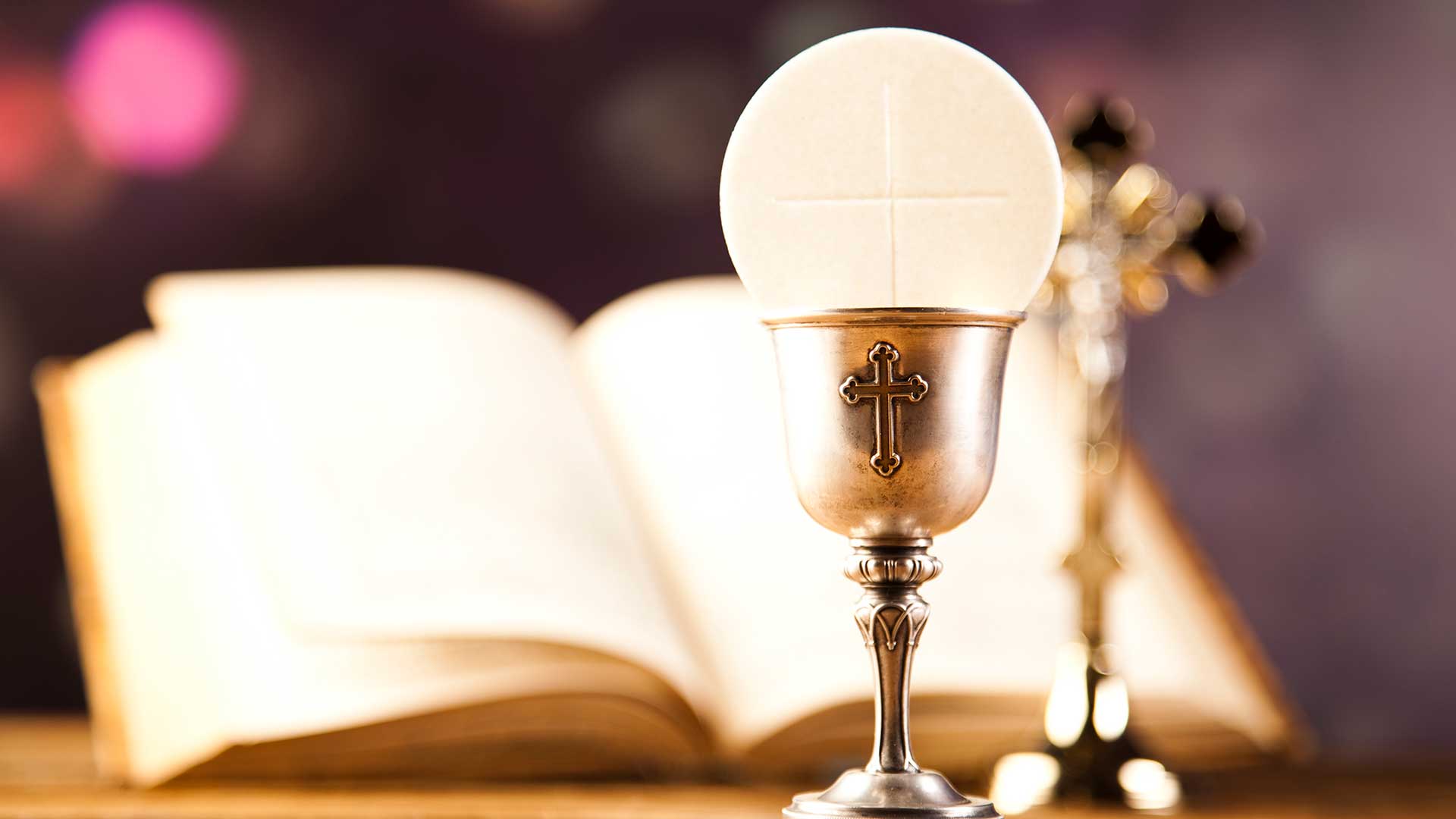The Monk Explains:

God is fully present in the Eucharist for us with his Body, Blood, Soul, and Divinity. With that said, this does not mean that God comes into the bread and the wine to be present in it. There is something different that happens. To understand this process we need to understand a conversion called Transubstantiation. Saint Thomas Aquinas says that all things are made of two parts: Substance and accidents. Transubstantiation is when something that is of one substance changes into being another substance without a change on the properties (accidents) that are sensible by the senses. The sensible properties of the thing that converts, called “Accidents” (appearances), do not change. Only the substance changes. The change is total and irreversible.
The substance is what something is; for instance, a rabbit is a rabbit. The accidents (appearances) of the rabbit are that it has four legs, a short tail, long ears, one head and long front theeth. These appearances or properties are called Accidents. According to Aristotle, there are nine types of accidents: quantity, quality, relation, place, time, posture, having or possission, action and passion. [5]
The process of transubstantiation is not one where one substance moves into another. It is a conversion process; for the example of the rabbit, if we want to transubstantiate a rabbit into an already existing horse, the conversion will change the substance of the rabbit and convert it into the already existing horse without changing the rabbit's accidents. After conversion, you would end up with a horse with four legs, a short tail, long ears, one head and long front theeth. The converted rabbit would now be a horse for as long as the rabbit accidents remain. The horse would now exist for as long as those accidents remain, possibly for less years than a horse. 265 [1] The horse remains a horse wherever the horse is, and the rabbit is now also the horse.
The Council of Trent declared that a conversion happens that to tne entire substance of the bread into the substance of the Body of Christ.[4] Thomas Aquinas believes on his phylosophy of being that God does not have a susbstance that differs from his being. His substance is subsistent and does not have accidents as only created things have accidents. God is subsistent (not created). What this means to us is that we can not describe perfectly the accidents of God, but we can describe the accidents of the incarnate Jesus, which is the part of the redemer that is created.
With the Eucharist, we have bread and wine initially converting into another substance. The accidents of the Bread, in this case, are that it is round, white or cream in color, and crunchy or semi crunchy. Transubstantiation here means that those accidents (appearances) will remain intact. The substance of what it is will be the Body, Blood, Soul, and Divinity of Jesus Christ, alive and resurrected. The Jesus in the Eucharist is the same body born of the Virgin Mary 234 [2] as a Monk named St. Paschasius Radbertus, a Monk of the Monastery of Corbie in France described. 233 [3] Additionally, transubstantiation means that Jesus did not come down to us from heaven. Jesus is still sitting at the right hand of the father due to the conversion during transubstantiation.
During transubstantiation, by only the word of our Lord and Savior, Jesus Christ, the Gifts that man brings, the created things, change into being the fullness of God and man united as the Body, Blood, Soul and Divinity of our Lord.[6]
[1] The Eucharist, Lawrence Feingold (Steubenville, OH, Emmaus Academic) 265.
Applying this two alternatives to the Eucharist, the two options are that either (a) christ's Body and Blood are moved into the bread and wine, which remain unchanged, or (b) that the bread and wine are converted into Christ's body and blood.
[2] Ibid 234.
Paschasius's central thesis is that Christ is present in the Eucharist with the same Body that was born of the Virgin, crucified, and risen.
[3] Ibid 233.
St. Paschasius Radbertus, a monk of the monastery of Corbie in France who later became it's abbot. Surprisingly, Paschasius's treatise, De Corpore et Sanguine Domini, is the first complete treatise on the Eucharist that we have.
[4] Aquinas on Transubstantiation: The Real Presence of Christ in the Eucharist (Washington, DC, The Catholic University of America Press) 29.
By the consecraion of the bread and wine, there takes the change [conversio] of the whole substance of the bread into the substance of the body of Christ our Lord, and of the whole substance of the wine into the substance of his blood. And the holy catholic church has suitable and properly called this change transubstantiation.
[5] Aquinas on Transubstantiation: The Real Presence of Christ in the Eucharist (Washington, DC, The Catholic University of America Press) 31.
[6] Corpus Christi: An Encyclopedia of the Eucharist(Collegeville, MN, The Liturgical Press) 196.
...the created things placed on the altar are "before being consecrated by the invocation of his name (antequam invocatione sui nominis consecrantur) , the substance of bread and wine; after the words of Christ, they are the body and blood of Christ."

"Father"- Jane Doe

"Lorem ipsum dolor sit amet, consetetur sadipscing elitr, sed diam nonumy eirmod tempor invidunt ut labore et dolore"- Jane Doe

"Lorem ipsum dolor sit amet, consetetur sadipscing elitr, sed diam nonumy eirmod tempor invidunt ut labore et dolore"- Jane Doe